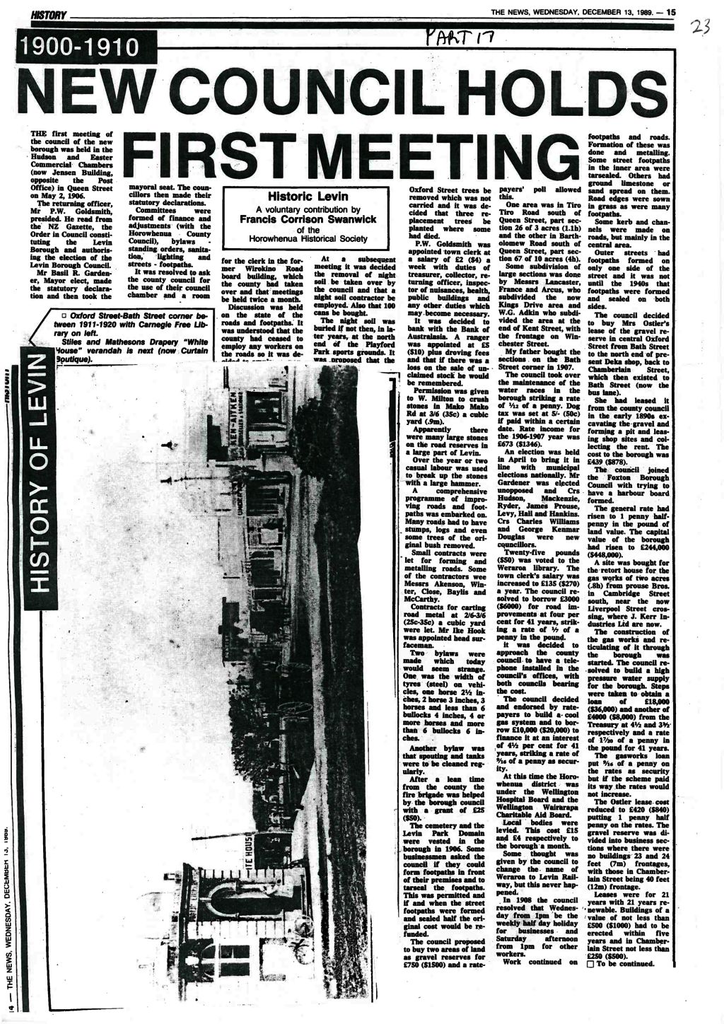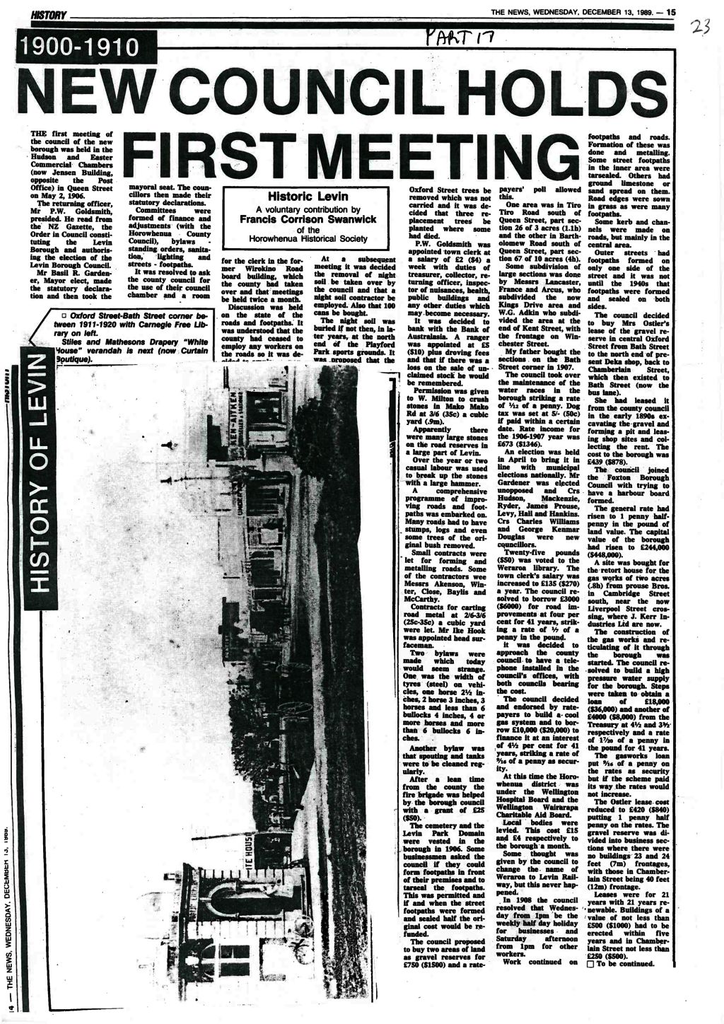The text that follows is the content of the attached PDF.
The returning officer, Mr P.W. Goldsmith, presided. He read from the NZ Gazette, the Order in Council constituting the Levin Borough and authorising the election of the Levin Borough Council.
Mr Basil R. Gardener, Mayor elect, made the statutory declaration and then took the mayoral seat. The councillors then made their statutory declarations.
Committees were formed of finance and adjustments (with the Horowhenua County Council), bylaws, standing orders, sanitation, lighting and streets & footpaths.
It was resolved to ask the county council for the use of their council chamber and a room for the clerk in the former Whirokino Road board building, which the county had taken over and that meetings be held twice a month.
Discussion was held on the state of the roads and footpaths. It was understood that the county had ceased to employ any workers on the roads so it was decided to [end of sentence missing].
At a subsequent meeting it was decided the removal of night soil be taken over by the council and that a night soil contractor be employed. Also that 100 cans be bought.
The night soil was buried if not then, in later years, at the north end of the Playford Park sports grounds. It was proposed that the Oxford Street trees be removed which was not carried, and it was decided that three replacement trees be planted where some had died.
P.W. Goldsmith was appointed town clerk at a salary of £2 ($4) a week with duties of treasurer, collector, returning officer, inspector of nuisances, health, public buildings and any other duties which may become necessary.
It was decided to bank with the Bank of Australasia. A ranger was appointed at £5 ($10) plus droving fees and that if there was a loss on the sale of unclaimed stock he would be recompensed.
Permission was given to W. Milton to crush stones in Mako Mako Rd at 3/6 (35c) a cubic yard (.9m).
Apparently there were many large stones on the road reserves in a large part of Levin.
Over a year or two casual labour was used to break up the stones with a large hammer.
A comprehensive programme of improving roads and footpaths was embarked on. Many roads had to have stumps, logs and even some trees of the original bush removed.
Small contracts were let for forming and metalling roads. Some of the contractors were Messrs Akenson, Winter, Close, Baylis and McCarthy.
Contracts for carting road metal at 2/6-3/6 (25c-35c) a cubic yard were let. Mr Ike Hook was appointed head surface man.
Two bylaws were made which today would seem strange. One was the width of tyres (steel) on vehicles, one horse 2 ½ inches, 2 horse 3 inches, 3 horses and less than 6 bullocks 4 inches, 4 or more horses and more than 6 bullocks 6 inches.
Another bylaw was that spouting and tanks were to be cleaned regularly.
After a lean time from the county, the fire brigade was helped by the Borough Council with a grant of £25 ($50).
The cemetery and the Levin Park Domain were vested in the borough in 1906. Some businessmen asked the Council if they could form footpaths in front of their premises and to tarseal the footpaths. This was permitted and if and when the street footpaths were formed and sealed half the original cost would be refunded.
The Council proposed to buy two acres of land as gravel reserves for £750 ($1500) and a ratepayers’ poll allowed this.
One area was in Tiro Tiro Road south of Queen Street, part section 26 of 3 acres (1.1h) and the other in Bartholomew Road south of Queen Street, part section 67 of 10 acres (4h).
Some subdivision of large sections was done by Messrs Lancaster, France and Arcus, who subdivided the now Kings Drive area and W.G. Adkin who subdivided the area at the end of Kent Street, with the frontage on Winchester Street.
My father bought the sections on the Bath Street corner in 1907.
The council took over the maintenance of the water races in the borough striking a rate of 1/12 of a penny. Dog tax was set at 5/- (50c) if paid within a certain date. Rate income for the 1906-1907 year was £673 ($1346).
An election was held in April to bring it in line with municipal elections nationally. Mr Gardener was elected unopposed and Crs Hudson, Mackenzie, Ryder, James Prouse, Levy, Hall and Hankins. Crs Charles Williams and George Kenmar Douglas were new councillors.
Twenty-five pounds ($50) was voted to the Weraroa library. The town clerk’s salary was increased to £135 ($270) a year. The council resolved to borrow £3000 ($6000) for road improvements at four per cent for 41 years, striking a rate of 1/7 of a penny in the pound.
It was decided to approach the County Council to have a telephone installed in the council’s offices, with both Councils bearing the cost.
The Council decided and endorsed by ratepayers to build a coal gas system and to borrow £10,000 ($20,000) to finance it at an interest of 4 ½ per cent for 41 years, striking a rate of 9/16 of a penny as security.
At this time the Horowhenua district was under the Wellington Hospital Board and the Wellington Wairarapa Charitable Aid Board.
Local bodies were levied. This cost £15 and £4 respectively to the borough a month.
Some thought was given by the Council to change the name of Weraroa to Levin Railway, but this never happened.
In 1908 the Council resolved that Wednesday from 1pm be the weekly half-day holiday for businesses and Saturday afternoon from 1pm for other workers.
Work continued on footpaths and roads. Formation of these was done and metalling. Some street footpaths in the inner area were tarsealed. Others had ground limestone or sand spread on them. Road edges were sown in grass as were many footpaths. Some kerb and channels were made on roads, but mainly in the central area.
Outer streets had footpaths formed on only one side of the street and it was not until the 1940s that footpaths were formed and sealed on both sides.
The Council decided to buy Mrs Ostler’s lease of the gravel reserve in central Oxford Street from Bath Street to the north end of present Deka shop, back to Chamberlain Street, which then existed to Bath Street (now the bus lane).
She had leased it from the county council in the early 1890s excavating the gravel and forming a pit and leasing shop sites and collecting the rent. The cost to the borough was £439 ($878).
The Council joined the Foxton Borough Council with trying to have a harbour board formed.
The general rate had risen to 1 penny half-penny in the pound of land value. The capital value of the borough had risen to £244,000 ($448,000).
A site was bought for the retort house for the gas works of two acres (.8h) from Prouse Bros. in Cambridge Street south, near the now Liverpool Street crossing, where J. Kerr Industries Ltd are now.
The construction of the gas works and reticulating of it through the borough was started. The Council resolved to build a high pressure water supply for the borough. Steps were taken to obtain a loan of £18,000 ($36,000) and another of £4000 ($8,000) from the Treasury at 4 ½ and 3 ½ respectively and a rate 1 7/20 of a penny in the pound for 41 years.
The gasworks loan put 9/16 of a penny on the rates as security, but if the scheme paid its way the rates would not increase.
The Ostler lease cost reduced to £420 ($840) putting 1 penny half penny on the rates. The gravel reserve was divided into business sections where there were no buildings 23 and 24 feet (7m) frontages, with those in Chamberlain Street being 40 feet (12m) frontage.
Leases were for 21 years renewable. Buildings of a value of not less than £500 ($1000) had to be erected within five years and in Chamberlain Street not less than £250 ($500).


